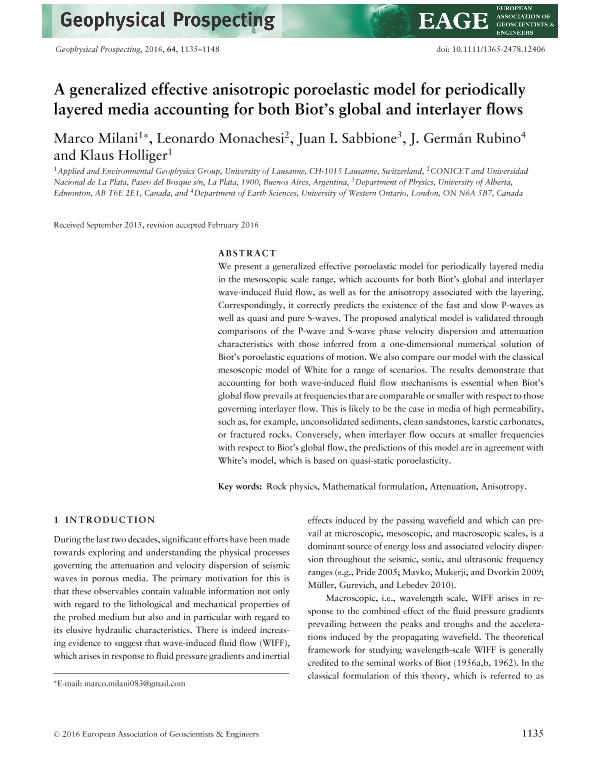Mostrar el registro sencillo del ítem
dc.contributor.author
Milani, Marco
dc.contributor.author
Monachesi, Leonardo Bruno

dc.contributor.author
Sabbione, Juan Ignacio

dc.contributor.author
Rubino, Jorge German

dc.contributor.author
Holliger, Klaus
dc.date.available
2018-08-08T18:37:40Z
dc.date.issued
2016-07
dc.identifier.citation
Milani, Marco; Monachesi, Leonardo Bruno; Sabbione, Juan Ignacio; Rubino, Jorge German; Holliger, Klaus; A generalized effective anisotropic poroelastic model for periodically layered media accounting for both Biot's global and interlayer flows; Wiley Blackwell Publishing, Inc; Geophysical Prospecting; 64; 4; 7-2016; 1135-1148
dc.identifier.issn
0016-8025
dc.identifier.uri
http://hdl.handle.net/11336/54630
dc.description.abstract
We present a generalized effective poroelastic model for periodically layered media in the mesoscopic scale range, which accounts for both Biot's global and interlayer wave-induced fluid flow, as well as for the anisotropy associated with the layering. Correspondingly, it correctly predicts the existence of the fast and slow P-waves as well as quasi and pure S-waves. The proposed analytical model is validated through comparisons of the P-wave and S-wave phase velocity dispersion and attenuation characteristics with those inferred from a one-dimensional numerical solution of Biot's poroelastic equations of motion. We also compare our model with the classical mesoscopic model of White for a range of scenarios. The results demonstrate that accounting for both wave-induced fluid flow mechanisms is essential when Biot's global flow prevails at frequencies that are comparable or smaller with respect to those governing interlayer flow. This is likely to be the case in media of high permeability, such as, for example, unconsolidated sediments, clean sandstones, karstic carbonates, or fractured rocks. Conversely, when interlayer flow occurs at smaller frequencies with respect to Biot's global flow, the predictions of this model are in agreement with White's model, which is based on quasi-static poroelasticity.
dc.format
application/pdf
dc.language.iso
eng
dc.publisher
Wiley Blackwell Publishing, Inc

dc.rights
info:eu-repo/semantics/openAccess
dc.rights.uri
https://creativecommons.org/licenses/by-nc-sa/2.5/ar/
dc.subject
Anisotropy
dc.subject
Attenuation
dc.subject
Mathematical Formulation
dc.subject
Rock Physics
dc.subject.classification
Meteorología y Ciencias Atmosféricas

dc.subject.classification
Ciencias de la Tierra y relacionadas con el Medio Ambiente

dc.subject.classification
CIENCIAS NATURALES Y EXACTAS

dc.title
A generalized effective anisotropic poroelastic model for periodically layered media accounting for both Biot's global and interlayer flows
dc.type
info:eu-repo/semantics/article
dc.type
info:ar-repo/semantics/artículo
dc.type
info:eu-repo/semantics/publishedVersion
dc.date.updated
2018-08-08T15:01:50Z
dc.journal.volume
64
dc.journal.number
4
dc.journal.pagination
1135-1148
dc.journal.pais
Reino Unido

dc.journal.ciudad
Londres
dc.description.fil
Fil: Milani, Marco. Universite de Lausanne; Suiza
dc.description.fil
Fil: Monachesi, Leonardo Bruno. Consejo Nacional de Investigaciones Científicas y Técnicas; Argentina. Universidad Nacional de La Plata; Argentina
dc.description.fil
Fil: Sabbione, Juan Ignacio. Consejo Nacional de Investigaciones Científicas y Técnicas; Argentina. University of Alberta; Canadá
dc.description.fil
Fil: Rubino, Jorge German. Consejo Nacional de Investigaciones Científicas y Técnicas; Argentina. University of Western Ontario; Canadá
dc.description.fil
Fil: Holliger, Klaus. Universite de Lausanne; Suiza
dc.journal.title
Geophysical Prospecting

dc.relation.alternativeid
info:eu-repo/semantics/altIdentifier/doi/https://dx.doi.org/10.1111/1365-2478.12406
dc.relation.alternativeid
info:eu-repo/semantics/altIdentifier/url/https://onlinelibrary.wiley.com/doi/abs/10.1111/1365-2478.12406
Archivos asociados
